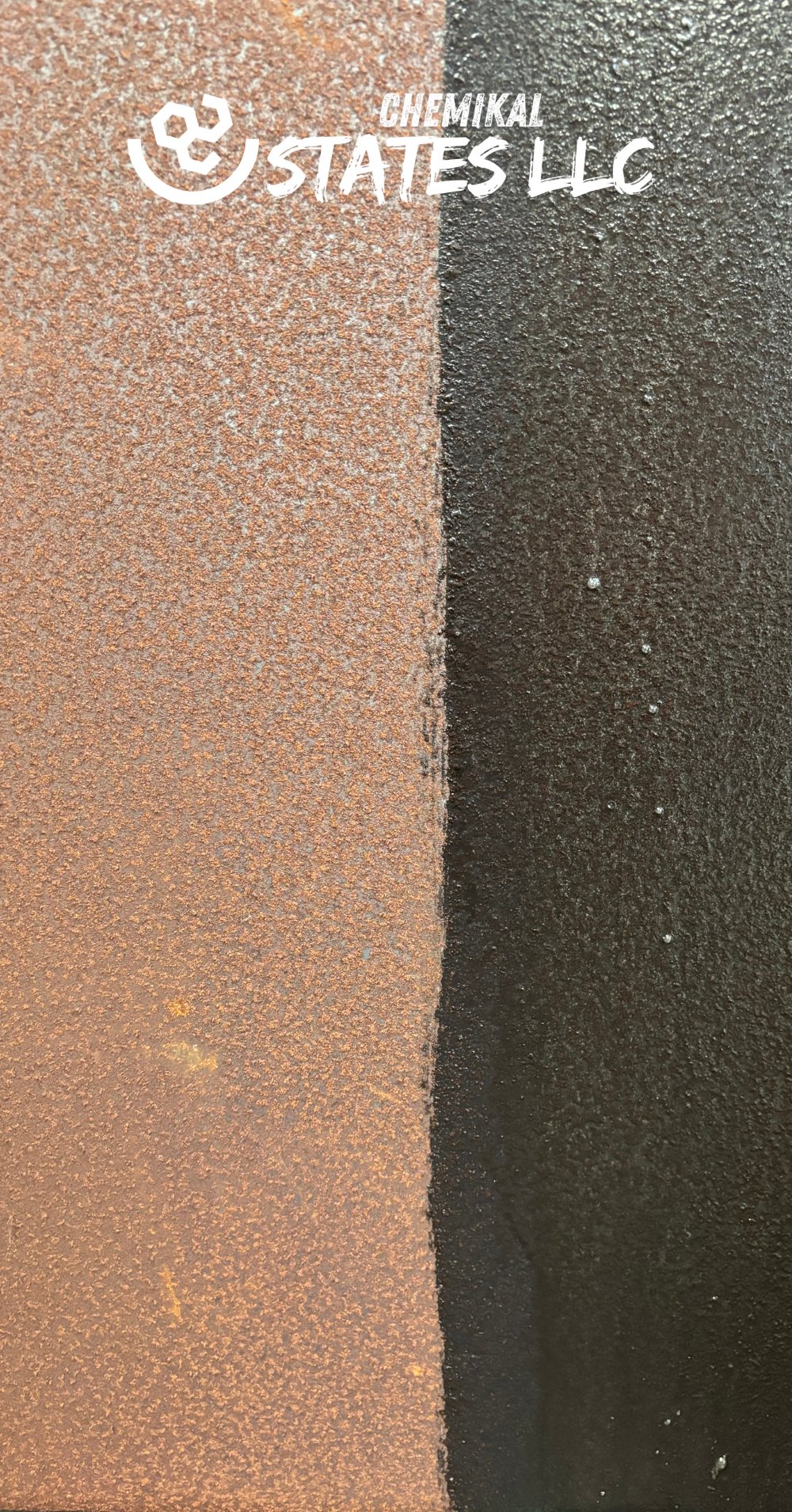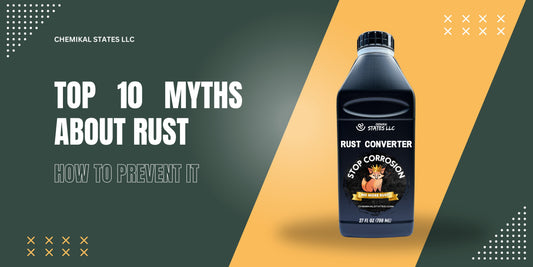
Case Study: How Chemikal States Rust Converter Revolutionized a Classic Car Restoration
Share
Introduction
Restoring a classic car is a labor of love, but it comes with its challenges—one of the biggest being rust. For car enthusiasts, rust can be a formidable foe, threatening to compromise the integrity and appearance of a beloved vehicle. In this case study, we explore how Chemikal States Rust Converter played a pivotal role in a successful classic car restoration, helping to save both time and money while delivering long-lasting results.
By the end of this story, you'll see why Chemikal States Rust Converter is the go-to solution for anyone serious about preserving the beauty and function of their classic car.
The Challenge: Tackling Severe Rust on a 1967 Ford Mustang
Client: John R., Classic Car Enthusiast
Location: Austin, Texas
Project: Full Restoration of a 1967 Ford Mustang
John R., a lifelong car enthusiast, had recently acquired a 1967 Ford Mustang. The car had significant sentimental value, but after decades of exposure to the elements, it was plagued by extensive rust. The rust was particularly severe on the undercarriage, wheel wells, and various other critical structural components. The challenge was not only to remove or neutralize the rust but also to ensure that it wouldn’t return, thereby preserving the car’s structural integrity and aesthetic appeal.
The Decision Process: Rust Converter vs. Traditional Rust Removal Methods
John was initially inclined to use traditional rust removal methods, which involved sandblasting and chemical rust removers. However, these methods had several drawbacks:
- Cost: Sandblasting and chemical treatments can be expensive and time-consuming, requiring professional equipment and skilled labor.
- Surface Damage: Traditional methods can be abrasive, potentially damaging delicate metal surfaces.
- Temporary Results: Without proper treatment, rust often returns, especially in environments prone to moisture.
John needed a solution that would be effective, easy to apply, and provide long-lasting protection against rust. After researching various options, he discovered Chemikal States Rust Converter.
Why Chemikal States Rust Converter Was Chosen
John chose Chemikal States Rust Converter for several key reasons:
- Ease of Use: The Rust Converter could be applied directly to the rusted areas without the need for extensive surface preparation. This saved time and reduced labor costs.
- Long-Term Protection: Unlike traditional rust removers that merely strip away rust, the Rust Converter chemically transformed the rust into a stable, non-corrosive compound, preventing further rusting.
- Preservation of Metal: The Rust Converter created a protective barrier, ensuring that the metal surfaces would remain intact and rust-free for years to come.
John was particularly impressed with the dual-action formula of Chemikal States Rust Converter, which not only converted the rust but also degreased the surface, making it ready for painting or further treatment.
The Application: How Chemikal States Rust Converter Was Used
Step 1: Surface Preparation
While Chemikal States Rust Converter doesn’t require extensive preparation, John ensured that the surfaces were clean and free of loose rust and debris. He used a wire brush to remove any flaky rust and wiped down the surfaces with a damp cloth to remove dust.
Step 2: Application of Rust Converter
John applied the Rust Converter using a paintbrush for precision. For larger areas, such as the undercarriage, he used a sprayer to ensure even coverage. The application process was straightforward and took significantly less time than traditional rust removal methods.
Step 3: Curing and Inspection
After applying the Rust Converter, John allowed it to cure for 24 hours. The rust transformed into a black, stable compound, indicating that the chemical conversion was complete. He inspected the treated areas and found that the rust was effectively neutralized, with no signs of further corrosion.
Step 4: Finishing Touches
To ensure long-lasting protection, John applied a primer and topcoat over the treated areas. The Rust Converter had created a smooth, paintable surface, making this final step easy and effective.
Results: A Fully Restored 1967 Ford Mustang
Thanks to Chemikal States Rust Converter, John was able to restore his 1967 Ford Mustang to its former glory. The rust was effectively neutralized, and the treated areas remained rust-free, even months after the restoration was completed. John’s project was not only a success but also a testament to the effectiveness of using Rust Converter over traditional rust removal methods.
Key Takeaways: Why Chemikal States Rust Converter Stands Out
1. Time-Saving Solution
The Rust Converter allowed John to skip the labor-intensive steps associated with traditional rust removal. This saved him both time and money, enabling him to focus on other aspects of the restoration.
2. Long-Term Durability
The Rust Converter provided long-lasting protection, ensuring that the rust would not return. This was particularly important for a classic car like the Mustang, where preservation is key.
3. Easy Application
With no need for specialized equipment or professional help, John was able to apply the Rust Converter himself, making it an accessible solution for DIY enthusiasts.
4. Versatile Use
The Rust Converter was effective on various parts of the car, from the undercarriage to the wheel wells, showcasing its versatility in different applications.
Why You Should Choose Chemikal States Rust Converter for Your Project
If you’re dealing with rust on any metal surface—whether it’s a classic car, outdoor furniture, or industrial equipment—Chemikal States Rust Converter is the solution you’ve been looking for. Our product is designed to stop rust in its tracks, providing long-lasting protection and ease of use. Here’s why it’s the best choice for your rust treatment needs:
- Dual-Action Formula: Converts rust and degreases surfaces, preparing them for further treatment.
- Long-Lasting Protection: Ensures that rust won’t return, even in harsh environments.
- Easy to Apply: No need for extensive preparation or specialized tools.
- Trusted by Professionals and DIYers Alike: Proven results across various applications.
Learn More and Purchase Today
Ready to protect your valuable metal assets? Visit our online store to purchase Chemikal States Rust Converter and experience the difference for yourself.
For more information on how to use our Rust Converter, check out these detailed guides and case studies:
- How to Use Rust Converter: A Step-by-Step Guide for Beginners
- Rust Converter vs. Rust Remover: Which One Do You Need for Your Project?
- The Ultimate Guide to Rust Converter: Protect Your Metal and Stop Corrosion
Special Offer: Save on Your First Purchase
For a limited time, enjoy 10% off your first purchase of Chemikal States Rust Converter. Use code RUSTFREE at checkout. Plus, get free shipping on all orders over $50. Don’t miss out—order now and take the first step towards rust-free, long-lasting metal surfaces.
Call to Action
Every moment you wait is a moment that rust continues to damage your valuable assets. Take action today by choosing Chemikal States Rust Converter—the proven solution for rust prevention and treatment. Join countless others who have successfully restored and protected their metal surfaces with our innovative product.
Visit our online store now to make your purchase, and get started on your restoration or maintenance project with confidence.
Protect. Preserve. Perfect. Chemikal States Rust Converter is your ultimate weapon against rust.










